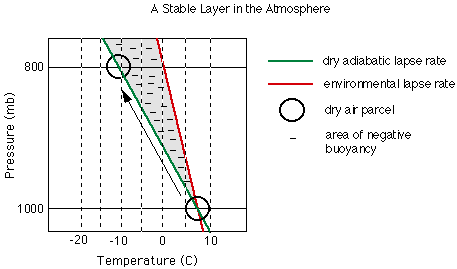
The stability of the atmosphere is basically determined by comparing the lapse rate of a parcel of air to the lapse rate of the surrounding air, which we also refer to as the environment. If we know the temperature and dew point of the air parcel before it begins to rise, then we can pretty accurately determine the temperature change as it rises, as discussed in A Review of Adiabatic Processes. Radiosonde and/or remote sensing data provide us with a profile of the environment with which to compare our rising air. But, keep in mind, our profile is merely a snapshot of the atmosphere. The sounding only gives us a view of the atmosphere at a point in time. Motion in the atmosphere makes these comparisons complicated because motion causes changes in the lapse rates we wish to compare. In order to simplify our discussion, we are going to make a few assumptions. These will be helpful to remember as we talk about stability.
We will assume:
Note: Click on any image or chart throughout the rest of Part 4 to view the image in a new window. This will allow you to view the image while reading the corresponding discussion (in the original window) simultaneously.
A stable atmosphere is one that is strongly resistant to change. If some external force such as orographic lifting or convergence pushes the air upward, the temperature of the rising air relative to the environment suggests that the air would prefer to go back to its original position. In other words, though a parcel is being forced up, it has negative buoyancy meaning it wants to sink to its original position where it was in equilibrium with the environment. If pushed down, the air has positive buoyancy and wants to rise. Imagine a cork floating on a lake. If you were to push the cork under water then release it, the cork would float back to the surface. Likewise, if you were to lift it out of the water then let it go, it would fall right back to the surface. Pushed under the water, the cork has positive buoyancy due to the difference in the density of the cork and the water. Lifted up out of the water, the cork has a negative buoyancy. But wait, doesn't the cork fall back to the water due to gravity? Gravity does pull the cork back to the surface, but it also has the same pull on the air molecules. The cork is more dense than the air so it falls or sinks to the surface where it is in equilibrium with its environment. This is very much like a stable atmosphere. In a stable atmosphere, if you lift a parcel of air, the temperature of the rising air will decrease fast enough that its temperature will always be colder than the temperature of the environment. Colder air sinks. If the force pushing the air up suddenly disappeared, the parcel would sink back down to its original position where its temperature and pressure would be in equilibrium with the environment. Another way of stating that the atmosphere or a layer in the atmosphere is stable is to say that the lapse rate of the rising air is greater than the lapse rate of the environment. (Note: A positive lapse rate indicates a decrease in temperature with height.) A layer characterized by a temperature inversion, defined by a negative lapse rate, is considered extremely stable. These inversions near the surface often occur in the early morning hours before sunrise.
In the diagram above, a parcel of dry air is lifted from a pressure of 1000 mb (100.0 kPa) at 7 degrees Celsius to a pressure of 800 mb (80.0 kPa). For simplicity we used a dry air parcel so the entire expansion is a dry adiabatic process. A comparison of the dry adiabatic lapse rate to the environmental lapse rate reveals that at every pressure level from 1000 mb (100.0 kPa) to 800 mb (80.0 kPa) the rising parcel is colder than the environment. If at any time during the expansion the lifting force disappeared, the parcel would sink back to the 1000 mb (100.0 kPa) pressure level. For example, at 800 mb (80.0 kPa) the temperature of the parcel is -10 degrees Celsius while the temperature of the surrounding air is about 1 degree Celsius. In the diagram, at every point above 1000 mb (100.0 kPa) the parcel has negative buoyancy because it is colder than the surrounding air. This is an example of a stable atmosphere. If the parcel in the example above had been a moist parcel, we would compare the environmental lapse rate to the dry adiabatic lapse rate below the LCL and to the moist adiabatic lapse rate above the LCL. The next classification of stability we will discuss is the neutral atmosphere.
 The Shodor
Education Foundation, Inc.
The Shodor
Education Foundation, Inc.